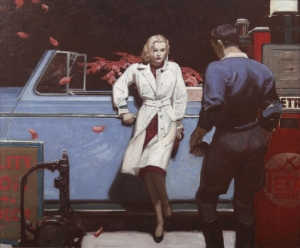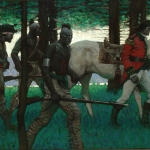
Mead Schaeffer (1898-1980)|The Blue Roadster, 1941; caption, “Joe,” she said, “I’ve got to talk to somebody. Can I talk to you?”|Illustration for “Blue Roadster” by Corey Ford in The American Magazine (May 1941): 48|Oil on canvas|Society of Illustrators, Permanent Collection, donated by the artist, accession number 047.007
The action in this illustration takes place at a gas station. Schaeffer positions the handsome man moving purposefully toward the blond-haired woman with his back to us. This device helps us to move into the painting’s space with him, and because his facial expression is not revealed, makes him appear slightly menacing.
The blond leans against a blue convertible. Despite the story’s title, the car is not a roadster (a two-seater car that has no roof, side or rear windows). If it were then there would be no need for the snapped canvas cover at the rear of the vehicle. The blond wears a tan rain-coat over a red dress, and plain pumps on her feet. With her curled hair falling forward over the right side of her face she appears sultry, classy, and just a bit coy. Her body leans against the car with her left foot lifted and resting against the car’s running board with her right hand holding the door pull. In the 40s automobiles were higher off the ground than they are today, so the running board served as a step to provide safe entry into the vehicle.
Every time I admire this illustration, I am struck by how off the proportions are between the car and the young woman—the car body appears to be just too long for reality. This is a common treatment in Mead Schaeffer illustrations. See how in this earlier work from 1921, Schaeffer does the same bit of elongation to the body of horse. By so doing Schaeffer helps to string the painting’s action together. In the Delaware Art Museum piece the long body of the horse links the action of the soldiers and Indians more tightly. In the illustration for “Blue Roadster,” the long blue body of the vehicle ties together the subject place and the actors in the scene.

Mead Schaeffer (1898-1980)|Colonial Troops with Indian Guides, 1921|Delaware Art Museum, 2003-28
Another interesting aspect to The Blue Roadster is Schaeffer’s ability to convey the bleaching nature of the gas station’s unseen overhead lights as they illuminate this night scene. While his image is starkly revealed within the realm of the station’s light, the details of the landscape outside, beyond the glow, are minimally indicated via the red of fall leaves seen behind the car. Notice how Schaeffer shifted the name on the gas pump, Tetro, similar to the name of a popular supplier. The gas pump itself is wonderfully deco or moderne in style and in the norm of the day its color is red.
The story’s author, Corey Ford (1902-1969), was an occasional member of the daily lunch at New York’s Algonquin Hotel, whose members called themselves “The Vicious Circle.” In addition to writing books and short stories, Ford also wrote scripts for a variety of 1930s and 40s movies including: Topper Takes a Trip, 1938; Winter Carnival, 1939; and Cloak and Dagger, 1946. In this short story, the “Blue Roadster,” Ford tells a tale of unrequited love on the part of the gas station attendant for a seasonal visitor, the blond. The story ends with the newly divorced blond dying in a car accident, and Joe, the mechanic, beginning to work on the wrecked blue car.
November 12, 2009
By Joyce K. Schiller, Curator, Rockwell Center for American Visual Studies
Norman Rockwell Museum






